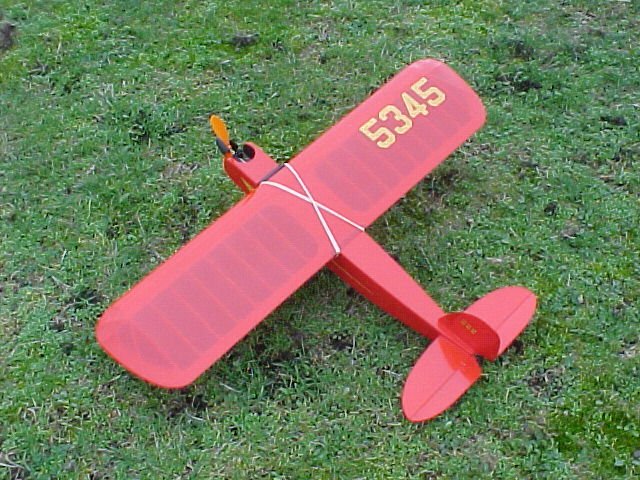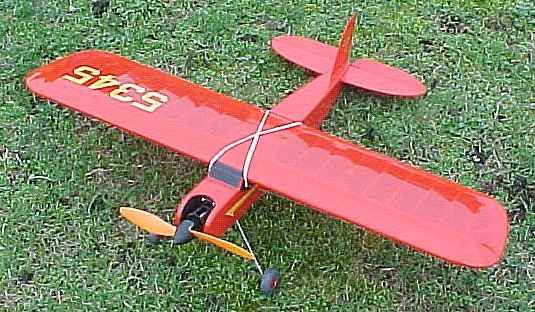

As a life-long (almost literally) flyer of control-line models, I have always been attracted by the possibilies of electric control-line models. In fact, I built my first one back in 1948! (More info here). My experiences with the electric conversion of the Bandit led to the thought that here was an ideal basis for a C/L model.
I did want something that looked more like an established design and chose to scale down the design that I have been flying in Vintage Stunt events for many years, the 'Box Car Chief'. I had already produced a plan to 60% scale which I had intended to build for a small IC engine, so the decision was made.
It's a very simple model and it went together quickly. I incorporated a stub motor stick in the nose which would accommodate the range of GWS IPS drive units. I started with a 3.5:1 unit (S1 gearing) with a 7 x 6 prop. Initially, this was switched on and off by a slide switch mounted immediately above the motor. Total weight with 6 x 250 mAh nicads came to 6.3 ounces (with Solarfilm Solite covering), which compared very favourably with the models that I built in my youth for 1cc diesels. The big problem was - lines.
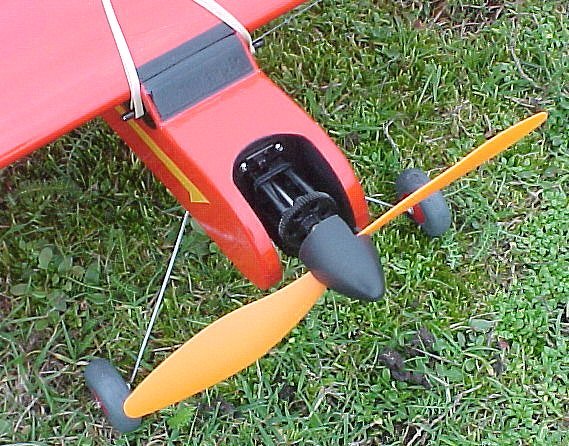
Those early models had all been flown on 30 foot long thread lines and this seemed the obvious starting point. Early attempts with the thinnest thread available all showed that the model flew well but the lines had so much stretch in them (modern materials!) that control was very soggy. A friend in the haberdashery trade found me some line that didn't stretch, though it was rather thicker tha I desired. There was a very pronounced 'bow' in the lines (see photo below) but at least I had control. Aerobatic performance was limited. Consecutive loops were possible, but the first attempt to recover from inverted was almost disastrous.
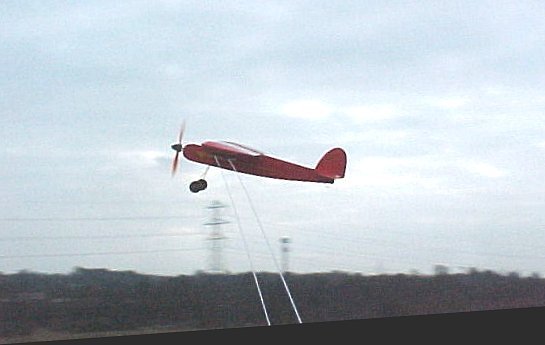
During all of this, it became obvious that I needed some way to switch the motor off after contact with the ground, otherwise say goodbye to the motor! The cure was very simple. Add a micro receiver and ESC (electronic speed controller). It's not too difficult to hold a small transmitter in your free hand and use the throttle function. I've already set about designing a simple Tx with a one channel encoder operated by a switch, but that's in the future.
An appeal for ideas on the Stuka Stunt Forum produced ideas like 'add a cell to the battery', which showed that I was on my own here. I had R/C models with the same power and weight that had a sparkling performance. It was thinner (and probably lighter) lines that I needed.
Shortening the lines and adding wing weight didn't help, I was looking for a quantum leap, not a small increment. I switched to a twin motor IPSD GWS unit of 4.1:1 ratio and 7 x 750 mAH NiMH cells. Note that two motors needed twice the cell capacity, otherwise there was a dramatic drop in power after a few seconds. There wasn't enough ground clearance to use the recommended prop, so I cut down a GWS 10 x 8 to give an 8 x 8. The weight was now up to nearly 9 ounces and the difference - negligible. I shortened the lines again to 25 feet and there was a slight improvement.
At this point it became very clear that my original thought was spot on. Knocking 2 feet off the line length had more effect than doubling the power.
It's worth pointing out here that the model would take off from short grass after a run of just 2 to 3 feet, so the power/weight ratio was obviously reasonable. I have lots of electric R/C models with very good flying performance, but which have trouble taking off at all.
I tried reversing the bellcrank so that the rear line was the 'down' line. No real improvement at all so scrub another well-known C/L theory.
One other thing that became clear was the models determination to roll down the lines when performing outside manoeuvres. Recovery from inverted usually resulted in my being able to see a plan view of the model. Stepping back and raising the arm while applying full 'up' would just about recover the situation, but not always. Any attempt to continue the manoeuvre on round into the inverted position meant swiping the ground inverted at best, or lots of damage at worst. I don't really have any idea why this is the case, other than possibly torque from the big, slow-revving prop. The full-size Box Car Chief doesn't have any sign of this tendency even on long lines.
One of the current and most experienced flyers of electric C/L models is Jan Odin, of Belgium. I remember that some years ago Jan told me that geared propellers were not the answer. I then remembered the 'Bandit' that indirectly started all this. So, the next move was to fit a Speed 280 motor complete with a Cox 5 x 3 prop. Currently, this still has the 7 x 750 NiMH battery (one more cell than the 'Bandit') and the all up weight is about an ounce less (than the 'Bandit').
The motor simply had sticky labels applied to both sides and it was then epoxied between the 'bearers'. Any good thump should simply knock it free and the motor can be cleaned by removing the labels. The ESC is a 'Rondo' type mounted directly on the back of the motor, making a neat and simple installation.
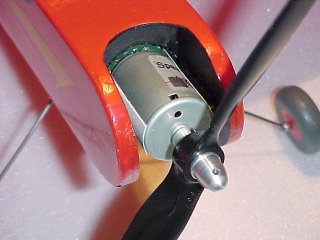
Most of the flying to this point had been done in fairly calm conditions. It seemed that some wind would help with the problem of the manoevres, but the one attempt to fly in a breeze resulted in the model having some difficulty getting past the upwind side of the circle. The first chance to fly after fitting the direct drive motor was actually fairly breezy, but I was probably going to break it again anyway.
As I expected, the take-off was more leisurely but, once airborne, it handled the wind quite well. Loops were rather large (on 25 foot lines!) and it actually recovered from inverted without any real problem. Horizontal eights were quite easy (at last!) but, again, quite large. The real test was to try a bunt - from inverted. OK, but very close to the ground on pullout. Now for a wingover. Fine over the top but no way would it pull out. I should have been less ambitious! No damage apart from a bent undercarriage - that's an improvement in itself.
There is still a long way to go, but it's getting there and I definitely need some thinner, lighter lines. There are problems with the model which now need to be addressed. It's very twitchy if you let the speed drop and it really doesn't want to turn too sharply. I think the CG needs to go forward and it needs a much larger elevator.
It's strange how we can overlook the obvious. On a sudden whim I decided to measure the thread lines I was using. They were no less than 0.030" diameter! Well now, I have a perfectly good set of 35 foot 0.008" wire lines that I use for a vintage diesel powered mode (Beebug). I had considered these to be too thick! So far, I've had one outing on these and they are a great improvement despite being a little too long (10 feet longer than the thread lines).
I'm much encouraged by this and have ordered some Spiderwire from the US via the web. In the meantime I'm producing a solid state timer which will turn the motor on after a delay (so I can get to the handle) and then turn it off after an adjustable time (say, 5 minutes). If successful, the circuit will eventually appear here.
Via the Stuka Stunt Forum I learned of a commercial device called an 'ESC Timer' which can be used to program the run time and speed of an electronic speed controller. I have now obtained one of these units and it does everything that I want. You can program a run up time and speed (in my case zero speed for 30 seconds) and a main running time and speed (in my case full power for 4 minutes). This gives me 30 seconds to get to the handle and a four minute flight. It even blips the throttle three times to warn you that the motor is about to stop. This function can be inhibited.
The unit can be programmed by using a servo in place of the ESC, which makes it easier to see what is happening. All this is done via a single button, which also serves as the start switch. The motor can be stopped at any time by pressing this same button. Finally, you can attach an external start button so that you can start via down elevator.
The unit has been designed to be used for F2B flying, although it is currently illegal for that event. Some people are optimistic about the possibility of getting electric models accepted for this event. If they knew how CIAM worked. they wouldn't be holding their breath!
Anyone interested in this device can contact Jean-Marie at: jpiednoi@club-internet.fr. He can accept payment via PayPal at that address. The price is currently $25. More info can be found here.
I now need some reasonable weather to get some air time on this device (and the model).
| Motor | Propeller | Battery | Controller | Weight | Performance |
|---|---|---|---|---|---|
| GWS IPS 3.5:1 | GWS 7 x 6 | 6 x 150 mAh Nicad | Slide switch | 6.3 oz. | Fair |
| GWS IPS 3.5:1 | Wattage 7.5 x 5 | 6 x 150 mAh Nicad | Slide switch | 6.3 oz. | Fair |
| GWS IPS 3.5:1 | GWS 7 x 6 | 6 x 150 mAh Nicad | Jeti 050 ESC & GWS Pico Rx | 6.5 oz. | Fair |
| GWS IPSD 4.1:1 | GWS 9 x 7 | 6 x 750 mAh NiMH | Jeti 050 ESC & GWS Pico Rx | 8.5 oz. | Good |
| Speed 280 | Cox 5 x 3 | 7 x 750 mAh NiMH | Kontronic 'Rondo' ESC & GWS Pico Rx | 9.0 oz. | Good |
| Speed 280 | Cox 5 x 3 | 7 x 750 mAh NiMH | Kontronic 'Rondo' ESC & JMP ESC timer | 9.0 oz. | Good |
| Material | Diameter | Length | Performance |
|---|---|---|---|
| Linen thread | 0.030" | 30 feet | Poor |
| Linen thread | 0.030" | 25 feet | Quite good |
| Steel wire | 0.008" | 36 feet | Quite good |
| Kevlar | 0.010" | 34 feet | Good |
I haven't recorded all of the combinations of lines and motors used because it was immediately clear that changing the lines had more effect than changing the power. All of the established stunt 'trimming' techniques (changing leadout position, changing wing weight, swapping up/down lines, etc.) had no effect whatever. The model is sensitive to CG position, but that only changes the turning power.
